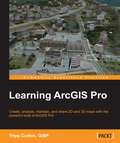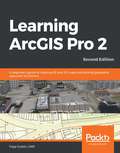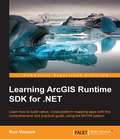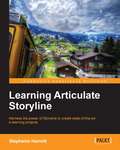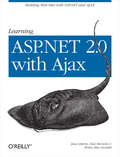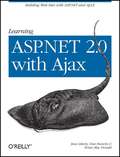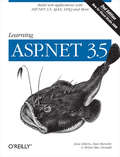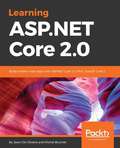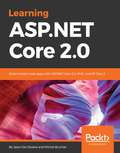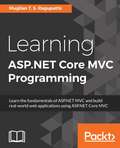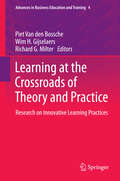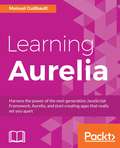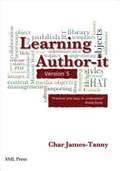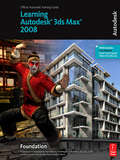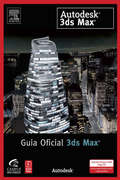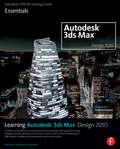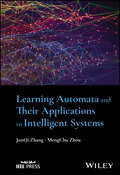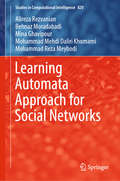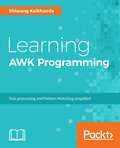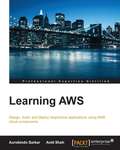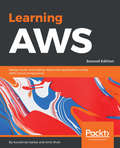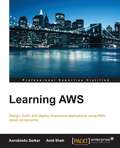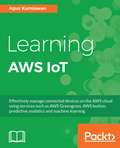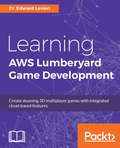- Table View
- List View
Learning ArcGIS Pro
by Gisp Tripp CorbinCreate, analyze, maintain, and share 2D and 3D maps with the powerful tools of ArcGIS Pro About This Book * Visualize GIS data in 2D and 3D maps * Create GIS projects for quick and easy access to data, maps, and analysis tools * A practical guide that helps to import maps, globes, and scenes from ArcMap, ArcScene, or ArcGlobe Who This Book Is For This book is for anyone wishing to learn how ArcGIS Pro can be used to create maps and perform geospatial analysis. It will be especially helpful for those that have used ArcMap and ArcCatalog in the past and are looking to migrate to Esri's newest desktop GIS solution. Though previous GIS experience is not required, you must have a solid foundation using Microsoft Windows. It is also helpful if you understand how to manage folders and files within the Microsoft Windows environment. What You Will Learn * Install ArcGIS Pro and assign Licenses to users in your organization * Navigate and use the ArcGIS Pro ribbon interface to create maps and perform analysis * Create and manage ArcGIS Pro GIS Projects * Create 2D and 3D maps to visualize and analyze data * Author map layouts using cartographic tools and best practices to show off the results of your analysis and maps * Import existing map documents, scenes, and globes into your new ArcGIS Pro projects quickly * Create standardized workflows using Tasks * Automate analysis and processes using ModelBuilder and Python In Detail ArcGIS Pro is Esri's newest desktop GIS application with powerful tools for visualizing, maintaining, and analyzing data. ArcGIS Pro makes use of the modern ribbon interface and 64-bit processing to increase the speed and efficiency of using GIS. It allows users to create amazing maps in both 2D and 3D quickly and easily. This book will take you from software installation to performing geospatial analysis. It is packed with how-to's for a host of commonly-performed tasks. You will start by learning how to download and install the software including hardware limitations and recommendations. Then you are exposed to the new Ribbon interface and how its smart design can make finding tools easier. After you are exposed to the new interface, you are walked through the steps to create a new GIS Project to provide quick access to project resources. With a project created, you will learn how to construct 2D and 3D maps including how to add layers, adjust symbology, and control labeling. Next you will learn how to access and use analysis tools to help you answer real-world questions. Lastly, you will learn how processes can be automated and standardized in ArcGIS Pro using Tasks, Models, and Python Scripts. This book will provide an invaluable resource for all those seeking to use ArcGIS Pro as their primary GIS application or for those looking to migrate from ArcMap and ArcCatalog. Style and approach This book includes detailed explanations of the GIS functionality and workflows in ArcGIS Pro. These are supported by easy-to-follow exercises that will help you gain an understanding of how to use ArcGIS Pro to perform a range of tasks.
Learning ArcGIS Pro 2: A beginner's guide to creating 2D and 3D maps and editing geospatial data with ArcGIS Pro, 2nd Edition
by Tripp CorbinCreate 2D maps and 3D scenes, analyze GIS data, and share your results with the GIS community using the latest ArcGIS Pro 2 features Key Features Get up to speed with the new ribbon-based user interface, projects, models, and common workflows in ArcGIS Pro 2 Learn how to visualize, maintain, and analyze GIS data Automate analysis and processes with ModelBuilder and Python scripts Book Description Armed with powerful tools to visualize, maintain, and analyze data, ArcGIS Pro 2 is Esri's newest desktop geographic information system (GIS) application that uses the modern ribbon interface and a 64-bit processor to make using GIS faster and more efficient. This second edition of Learning ArcGIS Pro will show you how you can use this powerful desktop GIS application to create maps, perform spatial analysis, and maintain data. The book begins by showing you how to install ArcGIS and listing the software and hardware prerequisites. You'll then understand the concept of named user licensing and learn how to navigate the new ribbon interface to leverage the power of ArcGIS Pro for managing geospatial data. Once you've got to grips with the new interface, you'll build your first GIS project and understand how to use the different project resources available. The book shows you how to create 2D and 3D maps by adding layers and setting and managing the symbology and labeling. You'll also discover how to use the analysis tool to visualize geospatial data. In later chapters, you'll be introduced to Arcade, the new lightweight expression language for ArcGIS, and then advance to creating complex labels using Arcade expressions. Finally, you'll use Python scripts to automate and standardize tasks and models in ArcGIS Pro. By the end of this ArcGIS Pro book, you'll have developed the core skills needed for using ArcGIS Pro 2.x competently. What you will learn Navigate the user interface to create maps, perform analysis, and manage data Display data based on discrete attribute values or range of values Label features on a GIS map based on one or more attributes using Arcade Create map books using the map series functionality Share ArcGIS Pro maps, projects, and data with other GIS community members Explore the most used geoprocessing tools for performing spatial analysis Create Tasks based on common workflows to standardize processes Automate processes using ModelBuilder and Python scripts Who this book is for If you want to learn ArcGIS Pro to create maps and, edit and analyze geospatial data, this ArcGIS book is for you. No knowledge of GIS fundamentals or experience with any GIS tool or ArcGIS software suite is required. Basic Windows skills, such as navigating and file management, are all you need.
Learning ArcGIS Runtime SDK for .NET
by Ron VincentThis book is for .NET developers who want to learn to build native Geographic Information System (GIS) application.
Learning Articulate Storyline
by Stephanie HarnettThis book provides one-on-one tutoring to help you quickly get up to speed with the basics while also learning how to best apply Storyline features in the context of the work you do.If you're an e-learning developer, writer, designer, subject matter expert, or all or any one of these, this book is for you. This book is not just for novices, but also for seasoned developers, transitioning from PowerPoint and Articulate Studio '09, and for those who are already working with Storyline.
Learning ASP.NET 2.0 with AJAX
by Dan Hurwitz Jesse Liberty Brian MacdonaldWith this book, web developers can build engaging and interactive sites and applications using Microsoft's latest web development tools -- ASP.NET 2.0 and the new ASP.NET AJAX framework. You learn to create applications that have all the great tricks you see on popular commercial web sites, such as order forms and the ability to interact with a database. And you can build pages that display information interactively without a page refresh. This straightforward tutorial explains how.Learning ASP.NET 2.0 with AJAX helps you master the concepts and techniques of Microsoft's tools with plenty of annotated examples, review quizzes, web construction exercises and chapter summaries, so you can practice new skills and test your understanding as you go. With it, you'll learn to: Master the fundamental skills of ASP.NET 2.0 to build professional quality web applicationsIntegrate new Ajax tools and CSS with ASP.NET 2.0 for flashier and more interactive sitesBuild applications with minimal coding using Visual Studio or its free counterpart, Visual Web DeveloperConnect your site with a database so that users can retrieve, interact and save dataDebug your application, deal with unexpected problems, and protect your site from malicious usersUse the community-maintained ASP.NET AJAX Control Toolkit to extend the controls that come with ASP.NET AJAXUse personalization tools to give your site a customized look for each user Ideal for beginning web developers, or those who are new to ASP.NET, this book gets you involved with your own learning through hands-on lessons that are clear and to the point. You get the chance to try out new techniques on the spot. Want to join the world of modern web development? This book will get you started.
Learning ASP.NET 2.0 with AJAX
by Jesse Liberty Dan Hurwitz Brian MacdonaldWith this book, web developers can build engaging and interactive sites and applications using Microsoft's latest web development tools -- ASP.NET 2.0 and the new ASP.NET AJAX framework. You learn to create applications that have all the great tricks you see on popular commercial web sites, such as order forms and the ability to interact with a database. And you can build pages that display information interactively without a page refresh. This straightforward tutorial explains how. Learning ASP.NET 2.0 with AJAX helps you master the concepts and techniques of Microsoft's tools with plenty of annotated examples, review quizzes, web construction exercises and chapter summaries, so you can practice new skills and test your understanding as you go. With it, you'll learn to: Master the fundamental skills of ASP.NET 2.0 to build professional quality web applications Integrate new Ajax tools and CSS with ASP.NET 2.0 for flashier and more interactive sites Build applications with minimal coding using Visual Studio or its free counterpart, Visual Web Developer Connect your site with a database so that users can retrieve, interact and save data Debug your application, deal with unexpected problems, and protect your site from malicious users Use the community-maintained ASP.NET AJAX Control Toolkit to extend the controls that come with ASP.NET AJAX Use personalization tools to give your site a customized look for each user Ideal for beginning web developers, or those who are new to ASP.NET, this book gets you involved with your own learning through hands-on lessons that are clear and to the point. You get the chance to try out new techniques on the spot. Want to join the world of modern web development? This book will get you started.
Learning ASP.NET 3.5: Build Web Applications with ASP.NET 3.5, AJAX, LINQ, and More
by Jesse Liberty Dan Hurwitz Brian MacdonaldWith this book, you will learn how to create engaging and interactive web applications using the latest version of the world's most popular web development platform: ASP.NET with AJAX, built on the productivity-enhancing features of Visual Studio 2008. All you need to get started is a basic knowledge of HTML and a desire to produce professional quality websites.Learning ASP.NET 3.5 introduces new skills in each new chapter and offers fully annotated and fully functional examples that you can put to work immediately. Each chapter adds detailed summaries, practice questions to ensure comprehension, and exercises so you can apply what you've learned to new situations. Written by the bestselling author team of Jesse Liberty, Dan Hurwitz, and Brian MacDonald, Learning ASP.NET 3.5 offers complete, up-to-date coverage of ASP.NET 3.5 and AJAX. The book includes:Chapters that are designed as a series of tutorials on different aspects of web development Examples in each chapter that illustrate how a new concept works. Different chapters feature either a single running example with several stages, or a series of smaller examples A single large example in the final chapter offers that uses everything the reader has learned VB, JavaScript, and SQL Cheat Sheet sidebars to help readers with no little or no background with those topics AJAX-style fully integrated into ASP.NET programming -- the way it should be taught and used If you want to get up to speed with the world's most popular web development technology, Learning ASP.NET 3.5 is the best resource for the job.
Learning ASP.NET 3.5, 2nd Edition
by Jesse Liberty Dan Hurwitz Brian MacdonaldWith this book, you will learn how to create engaging and interactive web applications using the latest version of the world's most popular web development platform: ASP.NET with AJAX, built on the productivity-enhancing features of Visual Studio 2008. All you need to get started is a basic knowledge of HTML and a desire to produce professional quality websites. Learning ASP.NET 3.5 introduces new skills in each new chapter and offers fully annotated and fully functional examples that you can put to work immediately. Each chapter adds detailed summaries, practice questions to ensure comprehension, and exercises so you can apply what you've learned to new situations. Written by the bestselling author team of Jesse Liberty, Dan Hurwitz, and Brian MacDonald, Learning ASP.NET 3.5 offers complete, up-to-date coverage of ASP.NET 3.5 and AJAX. The book includes: * Chapters that are designed as a series of tutorials on different aspects of web development, * Examples in each chapter that illustrate how a new concept works. Different chapters feature either a single running example with several stages, or a series of smaller examples, * A single large example in the final chapter offers that uses everything the reader has learned, * VB, JavaScript, and SQL Cheat Sheet sidebars to help readers with no little or no background with those topics, * AJAX-style fully integrated into ASP.NET programming -- the way it should be taught and used. If you want to get up to speed with the world's most popular web development technology, Learning ASP.NET 3.5 is the best resource for the job.
Learning ASP.NET Core 2.0
by Jason De OliveiraBeing able to develop web applications that are highly efficient while easy to maintain has become imperative in many businesses. ASP.NET Core 2.0 is an open source framework from Microsoft, which makes it easy to build cross-platform web applications that are modern and dynamic. This book will take you through all of the essential concepts in ASP.NET Core 2.0, so you can learn how to build powerful web applications.
Learning ASP.NET Core 2.0
by Jason De Oliveira Michel BruchetLearn how web applications can be built efficiently using ASP.NET Core 2.0 and related frameworks About This Book • Get to grips with the new features and APIs introduced in ASP.NET Core 2.0 • Leverage the MVC framework and Entity Framework Core 2 to build efficient applications • Learn to deploy your web applications in new environments such as the cloud and Docker Who This Book Is For This book is for developers who would like to build modern web applications with ASP.NET Core 2.0. No prior knowledge of ASP.NET or .NET Core is required. However, basic programming knowledge is assumed. Additionally, previous Visual Studio experience will be helpful but is not required, since detailed instructions will guide through the samples of the book.This book can also help people, who work in infrastructure engineering and operations, to monitor and diagnose problems during the runtime of ASP.NET Core 2.0 web applications. What You Will Learn • Set up your development environment using Visual Studio 2017 and Visual Studio Code • Create a fully automated continuous delivery pipeline using Visual Studio Team Services • Get to know the basic and advanced concepts of ASP.NET Core 2.0 with detailed examples • Build an MVC web application and use Entity Framework Core 2 to access data • Add Web APIs to your web applications using RPC, REST, and HATEOAS • Authenticate and authorize users with built-in ASP.NET Core 2.0 features • Use Azure, Amazon Web Services, and Docker to deploy and monitor your applications In Detail The ability to develop web applications that are highly efficient but also easy to maintain has become imperative to many businesses. ASP.NET Core 2.0 is an open source framework from Microsoft, which makes it easy to build cross-platform web applications that are modern and dynamic. This book will take you through all of the essential concepts in ASP.NET Core 2.0, so you can learn how to build powerful web applications. The book starts with a brief introduction to the ASP.NET Core framework and the improvements made in the latest release, ASP.NET Core 2.0. You will then build, test, and debug your first web application very quickly. Once you understand the basic structure of ASP.NET Core 2.0 web applications, you'll dive deeper into more complex concepts and scenarios. Moving on, we'll explain how to take advantage of widely used frameworks such as Model View Controller and Entity Framework Core 2 and you'll learn how to secure your applications. Finally, we'll show you how to deploy and monitor your applications using Azure, AWS, and Docker. After reading the book, you'll be able to develop efficient and robust web applications in ASP.NET Core 2.0 that have high levels of customer satisfaction and adoption. Style and approach Start an exciting journey to building high performance web applications using ASP.NET Core 2.0 and MVC
Learning ASP.NET MVC Programming
by Mugilan T. RagupathiThis book is for developers who want to learn to build web applications using ASP.Net MVC 6, developers who want to make a career building web applications using Microsoft technology, and developers who are working in Ruby on Rails or other web frameworks and want to learn ASP.Net MVC6. No knowledge of the ASP.Net platform or the .Net platform is required. Even though you do not need to have experience in C#, an understanding of the basic constructs (loops, conditionals, classes, and objects) of any modern programming language would be helpful.
Learning at the Crossroads of Theory and Practice
by Wim H. Gijselaers Piet Van den Bossche Richard G. MilterCore concepts in education are changing. For example, professional performance or expertise is not uniquely the fruit of specialist knowledge acquired at professional schools, but the sum of influences exerted by a complex web of continuous learning opportunities for which an individual is well (or ill) prepared by their schools and their workplace. The key contributory factors to professional expertise are how professional schools connect to professional practice, how schools prepare graduates for continuous learning, and how the workplace endorses continuous development. Thus, the question this volume addresses--how to design learning and working environments that facilitate the integration of these three elements--is at the heart of contemporary pedagogical theory. The authors also ask a second vital question: how do we educate learners that go on to maximize their life's learning opportunities by regulating their own ongoing learning? Learning at the Crossroads of Theory and Practice argues that with the theory of learning at a crossroads, this is an unprecedented opportunity for learning about learning. The book sheds light on different elements of this challenge: integrating theory and practice in business education, generating and fully exploiting workplace learning opportunities, and enriching our classrooms by coupling theoretical knowledge with the richness of real-life experience.
Learning Aurelia
by Manuel GuilbaultHarness the power of the next-generation JavaScript Framework, Aurelia, and start creating apps that really set you apart About This Book • Develop well-designed, decoupled, and testable single-page applications with Aurelia • Leverage the latest web standards to increase code performance, readability, and cross-compatibility • Understand how Aurelia is organized and use its innovative MVC approach to design professional-quality web apps Who This Book Is For This book is for JavaScript developers who want to build modern web apps with Aurelia. No prior knowledge of Aurelia is needed. What You Will Learn • Build a modern single-page web application • Understand the workflow of an Aurelia application • Design reusable web components, which can be shared and integrated into various frameworks and libraries • Write clean, modular, and testable code that will be easy to maintain and evolve • Use all the latest–and even future–web standards, so the application gathers minimal technical debt In Detail Aurelia is one of the most promising new JavaScript frameworks for mobile, desktop, and web, which makes developing powerful, modern web applications a straightforward task. Its power lies in its simplicity and clear workflow that enables developers to build next-generations apps for the web with ease. From initial structuring to full deployment, this book will serve as a step-by-step guide to develop a modern web application from scratch with the Aurelia framework. In addition to including a comprehensive coverage of various Aurelia framework features, this book will also show you how to utilize these features in the real world to develop a professional single-page web application. You'll see how to make the most out of Aurelia by understanding the Aurelia workflow and then applying it in real-world development tasks. By the end of the book, you will have learned to develop a clean and maintainable application in Aurelia from scratch. Style and approach This book will show you how to leverage the cutting edge features of Aurelia framework to develop modern web apps with a clear workflow. Using the modern architecture and features of Aurelia, this book will demonstrate the development of a web application from scratch.
Learning Author-it
by Char James-TannyLet Author-it guru Char James-Tanny teach you how to get the most from Author-it. Char has taught hundreds in her acclaimed classes, and now she has drawn from her extensive experience to create the definitive resource for learning Author-it. Whether you are new to Author-it or an experienced user, there is something here for you. If you are just starting out with Author-it, Learning Author-it will make the sometimes daunting learning curve for Author-it smoother and easier. You will learn how libraries work, how to wrap your head around Author-it's object-oriented structure, how to work with your content, and how to publish your output. If you are an experienced Author-it user, get a refresher from someone who uses Author-it like a technical writer. Char provides dozens of tips, helpful screenshots, and more than 150 tasks to help increase your efficiency (and lessen any frustration). And you'll find lots of tips and tricks that will improve your productivity.Inside the Book Understanding and setting up your library Understanding the authoring environment Creating content Reusing topic content Viewing, finding, and organizing topics Publishing the output Customizing objects for different outputs Maintaining the library Index
Learning Autodesk 3ds Max 2008 Foundation
by AutodeskLearning Autodesk® 3ds Max® 2008 | Foundation is your shortcut to learning 3ds Max quickly and effectively. You'll get hands-on experience with the key tools and techniques through easy-to-follow, step-by-step project-based lessons, while learning to model, animate, apply materials and render in both the games & design visualization pipelines. By the end of the book you'll have a sense of the entire production process as you work on real-life production examples.Whether you're a game artist or a graphic artist, Autodesk® 3ds Max® 2008 has the tools you need to succeed. Game Artists will gain in-depth knowledge of the world-class Biped character animation toolset, unparalleled polygon modeling and texturing workflow.Design Visualization Specialists such as architects, designers, and graphic artists, will gain the power to visually inform the design process through conceptual exploration, design validation and visual communication.Bonus features included on DVD:. Link to a 30-day trial of Autodesk® 3ds Max® software. Bonus short films and new software feature demos. Autodesk 3ds Max hotkeys reference guide. Free models from Turbo Squid worth $160. Autodesk® 3ds Max® 2008
Learning Autodesk 3ds Max 2010 Foundation for Games
by Autodesk3ds Max XXXX: presently under NDA. Learning 3ds Max XXXX Foundation is the key to unlocking the power of Autodesk 3ds Max, directly from the creators of one of the world's most powerful 3D animation and effects software products. Get hands on experience with the innovative tools and powerful techniques available in the new version of 3ds Max, through all new project-based lessons. Projects will include valuable game assets and examples. Topics will include modeling, animation, materials & mapping, rendering. Autodesk will be contributing assets (models and images) from high-profile studios. The DVD will include: 30-day trial of Max XXXX, bonus short films, demos, hotkey reference, free models from turbosquid.
Learning Autodesk 3ds Max Design 2010 Essentials: The Official Autodesk 3ds Max Reference
by AutodeskLearning Autodesk 3ds Max XXXX Essentials is a superb end-to-end reference that provides users with complete info on all of the features and options available in the latest version of 3ds Max, so that users can learn how to use 3ds Max confidently in a production environment. Each chapter offers a series of lessons - which introduce the functional areas of Max and go over all associated features (with examples), and then a lab (which demonstrates a practical application of the lesson). Together, all of the lessons deliver and sound and complete approach to revealing the functions, features, and principles of 3ds Max XXXX. New Bonus section on MaxScript covering techniques for automating repetitive tasks and customizing 3ds Max to make you more productive.The DVD includes: Project Scene & support files, Free models & texture maps from Turbo Squid, NEW!! HIGH VALUE: Autodesk product Sketchbook Pro (for character development) valued at $199.99 US.
Learning Automata and Their Applications to Intelligent Systems
by JunQi Zhang MengChu ZhouComprehensive guide on learning automata, introducing two variants to accelerate convergence and computational update speed Learning Automata and Their Applications to Intelligent Systems provides a comprehensive guide on learning automata from the perspective of principles, algorithms, improvement directions, and applications. The text introduces two variants to accelerate the convergence speed and computational update speed, respectively; these two examples demonstrate how to design new learning automata for a specific field from the aspect of algorithm design to give full play to the advantage of learning automata. As noisy optimization problems exist widely in various intelligent systems, this book elaborates on how to employ learning automata to solve noisy optimization problems from the perspective of algorithm design and application. The existing and most representative applications of learning automata include classification, clustering, game, knapsack, network, optimization, ranking, and scheduling. They are well-discussed. Future research directions to promote an intelligent system are suggested. Written by two highly qualified academics with significant experience in the field, Learning Automata and Their Applications to Intelligent Systems covers such topics as: Mathematical analysis of the behavior of learning automata, along with suitable learning algorithms Two application-oriented learning automata: one to discover and track spatiotemporal event patterns, and the other to solve stochastic searching on a line Demonstrations of two pioneering variants of Optimal Computing Budge Allocation (OCBA) methods and how to combine learning automata with ordinal optimization How to achieve significantly faster convergence and higher accuracy than classical pursuit schemes via lower computational complexity of updating the state probabilityA timely text in a rapidly developing field, Learning Automata and Their Applications to Intelligent Systems is an essential resource for researchers in machine learning, engineering, operation, and management. The book is also highly suitable for graduate level courses on machine learning, soft computing, reinforcement learning and stochastic optimization.
Learning Automata Approach for Social Networks (Studies in Computational Intelligence #820)
by Alireza Rezvanian Behnaz Moradabadi Mina Ghavipour Mohammad Mehdi Daliri Khomami Mohammad Reza MeybodiThis book begins by briefly explaining learning automata (LA) models and a recently developed cellular learning automaton (CLA) named wavefront CLA. Analyzing social networks is increasingly important, so as to identify behavioral patterns in interactions among individuals and in the networks’ evolution, and to develop the algorithms required for meaningful analysis. As an emerging artificial intelligence research area, learning automata (LA) has already had a significant impact in many areas of social networks. Here, the research areas related to learning and social networks are addressed from bibliometric and network analysis perspectives. In turn, the second part of the book highlights a range of LA-based applications addressing social network problems, from network sampling, community detection, link prediction, and trust management, to recommender systems and finally influence maximization. Given its scope, the book offers a valuable guide for all researchers whose work involves reinforcement learning, social networks and/or artificial intelligence.
Learning AWK Programming: A fast, and simple cutting-edge utility for text-processing on the Unix-like environment
by Shiwang KalkhandaText processing and pattern matching simplifiedKey Features-Master the fastest and most elegant big data munging language-Implement text processing and pattern matching using the advanced features of AWK and GAWK-Implement debugging and inter-process communication using GAWKBook DescriptionAWK is one of the most primitive and powerful utilities which exists in all Unix and Unix-like distributions. It is used as a command-line utility when performing a basic text-processing operation, and as programming language when dealing with complex text-processing and mining tasks. With this book, you will have the required expertise to practice advanced AWK programming in real-life examples. The book starts off with an introduction to AWK essentials. You will then be introduced to regular expressions, AWK variables and constants, arrays and AWK functions and more. The book then delves deeper into more complex tasks, such as printing formatted output in AWK, control flow statements, GNU's implementation of AWK covering the advanced features of GNU AWK, such as network communication, debugging, and inter-process communication in the GAWK programming language which is not easily possible with AWK. By the end of this book, the reader will have worked on the practical implementation of text processing and pattern matching using AWK to perform routine tasks.What you will learn-Create and use different expressions and control flow statements in AWK-Use Regular Expressions with AWK for effective text-processing -Use built-in and user-defined variables to write AWK programs-Use redirections in AWK programs and create structured reports-Handle non-decimal input, 2-way inter-process communication with Gawk-Create small scripts to reformat data to match patterns and process textsWho this book is forThis book is for developers or analysts who are inclined to learn how to do text processing and data extraction in a Unix-like environment. Basic understanding of Linux operating system and shell scripting will help you to get the most out of the book.
Learning AWS
by Aurobindo Sarkar Amit Shah<P><P>Design, build, and deploy responsive applications using AWS cloud components <P><P>About This Book <P><P>Build scalable and highly available real-time applications <P><P>Make cost-effective architectural decisions by implementing your product's functional and non-functional requirements <P><P>Develop your skills with hands-on exercises using a three-tiered service oriented application as an example <P><P>Who This Book Is For <P><P>This book is targeted at expert programmers and architects wanting to learn AWS. Some familiarity with Spring, MySQL, and RESTful web services is assumed. <P><P>What You Will Learn <P><P>Multi-tenant design approaches for SaaS applications <P><P>Planning dev, test, staging, and production environments <P><P>Design considerations for scalability and high-availability <P><P>Planning for DR <P><P>The security considerations and implementation of AWS applications <P><P>Production deployment processes and tools <P><P>Monitoring AWS applications using CloudWatch <P><P>Automating infrastructure using CloudFormation <P><P>In Detail <P><P>With the increasing global interest in leveraging cloud infrastructure, AWS Cloud from Amazon offers a cutting-edge platform for architecting, building, and deploying web-scale cloud applications. The variety of features available within AWS can reduce overall infrastructure costs and accelerate the development process for both large enterprises and startups alike. <P><P>Beginning with basic cloud concepts, you'll learn about the various cloud services models and the design implications of multi-tenant applications. You'll then design, implement, and deploy a multi-tier, scalable, highly-available and secure application on the AWS platform. At every step, we explain the key guiding principles driving real-world production-ready application architectures. Finally, you will learn how to automate your cloud infrastructure, set up operations, application monitoring, and DevOps pipeline.
Learning AWS.: Design, build, and deploy responsive applications using AWS Cloud components, 2nd Edition
by Aurobindo Sarkar Amit ShahDiscover techniques and tools for building serverless applications with AWS Key Features Get well-versed with building and deploying serverless APIs with microservices Learn to build distributed applications and microservices with AWS Step Functions A step-by-step guide that will get you up and running with building and managing applications on the AWS platform Book Description Amazon Web Services (AWS) is the most popular and widely-used cloud platform. Administering and deploying application on AWS makes the applications resilient and robust. The main focus of the book is to cover the basic concepts of cloud-based development followed by running solutions in AWS Cloud, which will help the solutions run at scale. This book not only guides you through the trade-offs and ideas behind efficient cloud applications, but is a comprehensive guide to getting the most out of AWS. In the first section, you will begin by looking at the key concepts of AWS, setting up your AWS account, and operating it. This guide also covers cloud service models, which will help you build highly scalable and secure applications on the AWS platform. We will then dive deep into concepts of cloud computing with S3 storage, RDS and EC2. Next, this book will walk you through VPC, building realtime serverless environments, and deploying serverless APIs with microservices. Finally, this book will teach you to monitor your applications, and automate your infrastructure and deploy with CloudFormation. By the end of this book, you will be well-versed with the various services that AWS provides and will be able to leverage AWS infrastructure to accelerate the development process. What you will learn Set up your AWS account and get started with the basic concepts of AWS Learn about AWS terminology and identity access management Acquaint yourself with important elements of the cloud with features such as computing, ELB, and VPC Back up your database and ensure high availability by having an understanding of database-related services in the AWS cloud Integrate AWS services with your application to meet and exceed non-functional requirements Create and automate infrastructure to design cost-effective, highly available applicationsWho this book is for If you are an I.T. professional or a system architect who wants to improve infrastructure using AWS, then this book is for you. It is also for programmers who are new to AWS and want to build highly efficient, scalable applications.
Learning AWS
by Amit Shah Aurobindo SarkarThis book is targeted at expert programmers and architects wanting to learn AWS. Some familiarity with Spring, MySQL, and RESTful web services is assumed.
Learning AWS IoT: Effectively manage connected devices on the AWS cloud using services such as AWS Greengrass, AWS button, predictive analytics and machine learning
by Agus KurniawanLearn to use AWS IoT services to build your connected applications with the help of this comprehensive guide. Key Features Gets you started with AWS IoT and its functionalities Learn different modules of AWS IoT with practical use cases. Learn to secure your IoT communication Book Description The Internet of Things market increased a lot in the past few years and IoT development and its adoption have showed an upward trend. Analysis and predictions say that Enterprise IoT platforms are the future of IoT. AWS IoT is currently leading the market with its wide range of device support SDKs and versatile management console. This book initially introduces you to the IoT platforms, and how it makes our IoT development easy. It then covers the complete AWS IoT Suite and how it can be used to develop secure communication between internet-connected things such as sensors, actuators, embedded devices, smart applications, and so on. The book also covers the various modules of AWS: AWS Greengrass, AWS device SDKs, AWS IoT Platform, AWS Button, AWS Management consoles, AWS-related CLI, and API references, all with practical use cases. Near the end, the book supplies security-related best practices to make bi-directional communication more secure. When you've finished this book, you'll be up-and-running with the AWS IoT Suite, and building IoT projects. What you will learn Implement AWS IoT on IoT projects Learn the technical capabilities of AWS IoT and IoT devices Create IoT-based AWS IoT projects Choose IoT devices and AWS IoT platforms to use based on the kind of project you need to build Deploy AWS Greengrass and AWS Lambda Develop program for AWS IoT Button Visualize IoT AWS data Build predictive analytics using AWS IoT and AWS Machine Learning Who this book is for This book is for anyone who wants to get started with the AWS IoT Suite and implement it with practical use cases. This book acts as an extensive guide, on completion of which you will be in a position to start building IoT projects using AWS IoT platform and using cloud services for your projects.
Learning AWS Lumberyard Game Development
by Dr Edward LavieriCreate stunning 3D multiplayer games with integrated cloud-based features About This Book * Build a multiplayer 3D game from scratch using the features of Amazon's Lumberyard * Explore the world of Lumberyard along with Twitch and various key Amazon Web Services to build a game * This step-by-step practical guide will teach you how to build cross-platform games using Lumberyard Who This Book Is For The book caters for those who have an interest or desire to create their own games, either as a hobbyist or to enhance their skills as a professional games developer. The book requires previous knowledge of software development. Experience with C++ will also be beneficial. What You Will Learn * Explore Lumberyard's graphical user interface * Create stunning game worlds * Use Geppetto editor to create 3D characters * Create and animate game characters using Lumberyard's toolset * Create impressive gameplay to add multiplayer functionality to your game * Debug and play your 3D game * Add multiplayer functionality to your game using Amazon GameLift * Integrate with Amazon cloud services to support cloud computing and storage * Engage your users during gameplay with Twitch In Detail Amazon's Lumberyard is a 3D cross-platform game development engine for building high-quality AAA games. It makes the process of creating multi-player games and adding realistic characters, stunning terrains, and special effects much faster and more efficient. This book will show you how to use Lumberyard to create a multiplayer 3D game with cloud computing, storage, and Twitch integration for user engagement. We will start with an introduction to Lumberyard and provide an overview of its capabilities and integration options. Once the game engine is installed, we'll guide you through the creation of an immersive game world with characters. You'll add animations and audio to bring the game to life. We'll explore external interactions to support live multiplayer game play, data storage, user engagement, and the back end. By the end of the book, you will be efficient in building cross-platform games using Lumberyard. Style and approach This step-by-step tutorial is filled with practical examples that will introduce you to the game engine's interface, as well as setting up your development environment.
